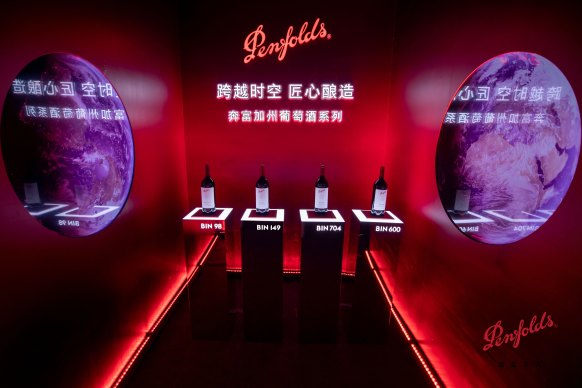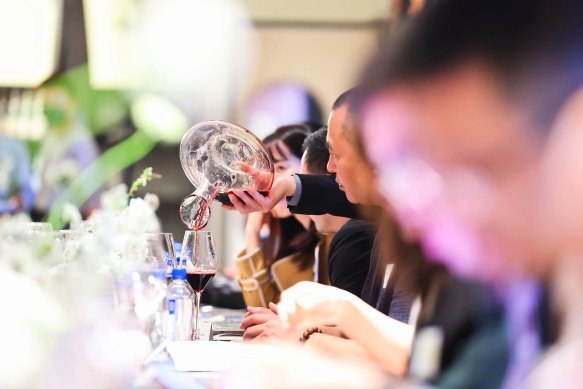
Aussie wines are flowing in China again, but the relief over punitive tariffs being lifted this year faces a sobering reality check from a market that has confounded global expectations.
The value of China’s wine imports more than halved between 2019 and 2023, from $3.3 billion to $1.5 billion, reflecting a market that has been turned on its head since the de facto ban on Australia’s product which began pre-COVID.

Australia is returning to a much-changed market for wine in China
“The market has shrunk hugely in terms of consumer interest in wine and that’s not showing any signs of reversing post COVID,” Kym Anderson, a respected wine academic who heads the Wine Economics Research Centre at the University of Adelaide, says.
It reflects a profound change in China’s wine consumption which peaked in 2012 and had dropped more than 65 per cent by 2022, according to Anderson. It is an issue he detailed in a research paper last year titled: “What’s happened to the wine market in China?”
“The decline really started when [President] Xi [Jinping] came to office and started tightening up on corruption and public banquets and gift giving … and since 2017 consumption has gone down by about two-thirds or more. So it’s nothing to do with COVID.”
The plunge in wine consumption was a stunning reversal for the country that promised to dominate the industry’s future.
In France’s wine regions, dozens of Chinese-owned vineyards are up for sale at knockdown prices as bottles of Bordeaux lose their lustre as luxury gifts for China’s wealthy elite. Even worse, experts say France’s tannin-heavy wines might not suit the Chinese pallet.
Anderson nominates other factors for the continuing decline, including the Chinese preference for consuming wine outside of the home as a social activity. During COVID, and with the current economic malaise, it has cruelled its consumption in comparison to spirits and beer which dominate as everyday tipples.
Taylor Wines boss Mitchell Taylor, agrees.
“The Chinese market has never completely recovered from that [COVID] disruption and on top of that, at-home consumption is not a natural way for Chinese consumers to enjoy wine – they much prefer to go out,” he says.
But it may also indicate wine’s status is more that of an exotic good than a beverage staple – dropping from 4.6 per cent of China’s alcohol consumption in 2012 to just 1.5 per cent at present.

Treasury Wine Estates began making its own China-made version of its Penfolds wines as part of a strategy to keep its brand in China when harsh tariffs were imposed on Australian exports.
President Xi’s crackdown on ostentatious gift-giving and wine’s Western association back this theory.
Anderson writes the contrast with beer and spirits consumption “suggests there has been either a preference swing against wine (because it is viewed politically as an exotic product?) and/or a greater premiumisation of preferences for wine”.
The latter argument is looking like a silver lining for Aussie producers. Whatever the state of the wine market in China, consumers are keen to reacquaint their love affair with top-shelf Australian wines, according to Taylor.
What helps, he says, is Australia’s fruit-driven flavour and innovative touches like thermo-chromatic labels that change colour when the wine reaches its optimal drinking temperature.

Wine is our premium product in China.
“China is probably the market that really understands our flavour profile,” he says. “They love the forward fruit flavours and the smoothness that we get in our high-quality wines.”
Anderson points to an interesting new trend where Chinese women are interested in wine, particularly white wines.
“White wine goes okay with Chinese food [and] amongst the younger drinkers, a lot of them are females now, which is a bit of a surprise.”
Whatever the reason, Australian wines have staged an extraordinary recovery when it comes to raw export numbers at least.
The sector’s association, Wine Australia, reported that Australian wines had regained the No.2 spot behind France as the top wine exporter to China for the year ended August 2024 despite the fact local exports only restarted in March this year.

Taylor Wines managing director Mitchell Taylor says the demand for its premium wines in China took it by surprise.Credit: Peter Rae
Australia accounted for 25 per cent of the bottled wine market with an average value of $US18.28 ($28.11) a litre, more than double the value of the average French wine.
Both of these stats were noted by Taylor, who said the group is re-stocking in China at the top premium level, which shows the money is still there for quality wines.
“We’re now rushing in,” he says, “The demand at the very high end has exceeded our expectations.”
Despite shipping four containers of wine over to China, Taylors is now flying in drops like its $1000 The Legacy Cabernet Sauvignon.
“We’ve got to do some air freighting to make sure we don’t go out of stock, and we’re rushing through more containers so that we get them there in time for the important Chinese New Year gift-giving occasion.”
The caveat is that Australian winemakers are refilling their distribution channels, which means the recent success does not reflect consumers actually buying the wines in restaurants, bars and bottle shops.

China’s property market turmoil has hit consumer confidence and spending on items like wine.Credit: Bloomberg
And the economic problems will make that transition to consumer sales all the harder as Taylor notes following a recent trip to China.
“What I found fascinating was that they were really cautious,” Taylor says. The feedback on the ground in China he received cited issues like Trump trade worries, a faltering stock market and, most significantly, falling house prices, which is having a significant impact on personal wealth and financial security.
“Consumer confidence is not there at all. It’s making them feel very insecure and is lifting the rate of savings,” he says.
Taylor is not the only one noticing China’s thirst for expensive Aussie wines despite the economic turmoil.
The titan of Australia’s wine industry, Penfold’s owner Treasury Wine Estates, has plenty of experience with this thanks to its top-shelf French, Chinese and US-sourced wines, which it was able to continue selling in China throughout the Australian wine ban.
“What we’ve been seeing at the upper end of the category, and this is from genuine consumption data from e-commerce, [is] that RMB500 ($106) and above has been growing double-digits in ’23 and accelerating that growth rate in ’24 as well,” Penfolds boss, Tom King, said at the group’s annual results in August.
Treasury is an important bellwether for the Australian wine industry and is closely watched by its stock market investors.
As Taylor points out, Australia’s winemakers all benefit from the “Penfolds factor” in China as the most prominent premium brand.
For Anderson, our premium wine success reflects a reality not much different to Australia: The rich can still afford to spend on premium wines with abandon; it is the aspirational classes who are being hit by the economic woes.
“If you’re in that market at the very top like Penfold’s Grange, then of course, that market is separable from the rest – the billionaires will buy that, whatever’s happening.”
Australia’s strong bounce back into the market means the only question is, can our wines reclaim top position and a lion’s share of whatever market remains in China. No one is thinking of a return to the $1.2 billion of sales recorded in 2019 before the ban.
Taylor says more will become clear after the Chinese New Year.

Gift giving during Chinese New Year celebrations remains a critical success point for the wine market, accounting for 60 per cent of annual sales. Credit: AP
“That’s where the majority of the activity takes place. About 60 per cent of annual sales you expect around that period. So after that festival, I would hope where we’re starting to get towards that 800 to 900 million [dollar] mark for the industry. But then I’d have … a note of caution on how the depletions [retail sales] go from there,” he says.
It is still expected to take a long time for Australia’s winemakers to get within shouting distance of the numbers they achieved in China pre-ban.
Loading
E&P forecasts that Treasury’s exports to China could add $100 million to the group’s earnings by 2026, roughly half the earnings Treasury received in 2019.
Anderson is among those who are cautious about predicting anything but a hard slog after the first blush of re-entry to China wears off.
But he does not expect the market to defy long-term global consumption trends forever.
You only need to look across to Hong Kong to see why.
“Their levels of consumption, if you think of [Hong Kong] as being mostly Chinese people these days, is three times the per capita consumption of mainland China,” Anderson says.
“If their habits or their preferences for beverages move in the way that they have for Hong Kong, then one can anticipate that, longer term, there’s going to be three times as much [wine] consumed per capita.”
The Business Briefing newsletter delivers major stories, exclusive coverage and expert opinion. Sign up to get it every weekday morning.



























